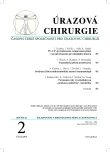TRAUMATIC PULMONARY PSEUDOCYST (TPP)
Authors:
Jiří Škach 1; Alexej Skačkov 2; Peter Hromádka 1
Authors‘ workplace:
Chirurgické oddělení, Krajská nemocnice Liberec a. s.
1; General Surgery Department, Regional Hospital Liberec
1; Traumatologicko-ortopedické centrum, Krajská nemocnice Liberec a. s.
2; Traumatology and Orthopeadic Department, Regional Hospital Liberec
2
Published in:
Úraz chir. 22., 2014, č.2
Overview
INTRODUCTION:
Pulmonary paremchymal laceration with pneumatocele and intraparenchymal hemorrhagie is a rare diagnosis in blunt thoracic trauma mainly in young adults. Blunt chest trauma manifests commonly as a parenchymal contusion and fractures of ribs. In rare cases pseudocavitation may also be seen on the chest X ray or CT. They are to be differentiated from other causes of pulmonary cavitatiton which are often done based on medicine history of patient.
CASE REPORT:
20-years-old man intoxicated with alcohol was addmited to hospital in regime of polytraumatized patient. There was unclear information of high fall. On CT scan, there was no sceletal damage and there were, except bilateral lung contusions, presented only cavitary lung lesions in the left lower lobe. Due to continuous bleeding (hemoptysis) the left inferior pulmonary lobectomy was performed with very good results.
DISCUSSION:
The so called traumatic pulmonary pseudocyst usually has a benign course and needs only observation. The reasons, follow-ups and review of a literature are discussed.
CONCLUSION:
Traumatic pulmonary pseudocyst is a rare diagnosis observed usually on CT scan mainly in young adults with history of blunt chest trauma. Nonoperative treatment and observation in hospital are in most cases effective. Invasive methods and operative treatment as lung resections are supposed to be reserved for complications.
KEY WORDS:
Laceration, pneumatocele, pseudocyst.
Sources
1. BULPA P. et al. Endobronchial drainage in case of infected posttraumatic pulmonary pseudocyst: an alternative to surgery? Intensive Care Med. 2011, 37, 352–354.
2. CAI M.H., LEE W.J. Images in emergency medicine. Traumatic pneumatocele. Ann Emerg Med. 2007, 49, 1, 111.
3. DALLESSIO JJ., MARKLEY MA., LOHE A. et al. Management of a traumatic pulmonary pseudocyst using high-frequency oscillatory ventilation. J Trauma. 1995, 39, 1188–1190.
4. DZIAN, A. et al. Pl’úcna pneumatokéla u dospelého pacienta – kazuistika. Rozhl Chir. 2012, 91, 679–682.
5. FAGKREZOS, D., GIANNILA, M., MANIATIS, P. et al. Post-traumatic pulmonary pseudocyst with hemopneumothorax following blunt chest trauma: a case report. J Med Case Rep. 2012, 6, 356.
6. GUPTA, N., GEORGE, J., GUPTA, R.C., DIXIT, R. Traumatic pulmonary pseudocyst. Int J Crit Illn Inj Sci. 2013, 3, 155–158.
7. HÁJEK M. et al. Traumatologie hrudníku. Avicenum: Praha, 1980. 126 s.
8. HERTH F. et al.. Endoscopic drainage of lung abscesses:technice and outcomes. Chest. 2012, 127,1378–1381.
9. CHON, SH., LEE, CB., KIM, H. et al. Diagnosis and prognosis of traumatic pulmonary pseudocysts: a review of 12 cases. Eur J Cardiothorac Surg. 2006, 29, 819–823.
10. INAN M. et al. Blunt chest trauma in childhood. ANZ J Surg. 2007, 77, 682–685.
11. KAIRA, K., ISHIZUKA, T., YANAGITANI, N. et al. Pulmonary traumatic pneumatocele and hematoma. Jpn J Radiol. 2009, 27, 100–102.
12. KATO, R., HORINOUCHI, H., MAENAKA, Y. Traumatic pulmonary pseudocyst. Report of twelve cases. J Thorac Cardiovasc Surg. 1989, 97, 309–312.
13. KOCER, B., GULBAHAR, G., GUNAL, N. et al. Traumatic pulmonary pseudocysts: two case reports. J Med Case Reports. 2007, 1, 112.
14. MASE, T., KATO, S., AOYAMA, T. et al. Immediate surgical treatment for the traumatic pulmonary pseudocyst: a case report. Kyobu Geka. 1996, 49, 876–879.
15. MELLONI, G., CREMONA, G., CIRIACO, P. et al. Diagnosis and treatment of traumatic pulmonary pseudocysts. J Trauma. 2003, 54, 737–743.
16. MOORE, FA., MOORE, EE:, HAENEL, JB. Et al. Post-traumatic pulmonary pseudocyst in the adult: pathophysiology, recognition, and selective management. J Trauma.1989, 29, 1380–1385.
17. QUIGLEY, MJ., FRASER, RS. Pulmonary pneumatocele: pathology and pathogenesis. Am J Roentgenol. 1988, 150,1275–1277.
18. QUWANTLI, Z.,SIVARAMAN, S., RISHI M. Posttraumatic pulmonary pseudocysts. Chest. 2011, 140, 112.
19. RAHIMI-RAD, MH., MOHAMMADI, A. Multiple bilateral traumatic pulmonary pseudocysts in a 53 year-old male diagnosed retrospectively. Pneumologia. 2010, 59, 84–86.
20. SHIRAKUSA, T. Traumatic lung pseudocyst. Thorax. 1987, 42, 516–519.
21. SCHIMPL, G., SCHNEIDER, U. Traumatic pneumatoceles in an infant: case report and review of the literature. Eur J Pediatr Surg. 1996, 6,104–106.
22. STATHOPOULOS, G., CHRYSIKOPOULOU, E. et al. Bilateral traumatic pulmonary pseudocysts: case report and literature review. J Trauma. 2002, 53, 993–996.
23. TSITOURIDIS, I. et al. Traumatic pulmonary pseudocysts: CT findings. J Thorac Imaging. 2007, 22, 247–251.
24. VOUTSAS, V., GIAKAMOZIS, A., LAZARIDIS, T. Post-traumatic lung pseudocysts: two case reports in ICU patients. J Thorac Dis. 2012, 4, 74–78.
25. ZHENG, Z., PAN, Y., GUO, F. et al. Traumatic pulmonary pseudocyst: a rare but noteworthy entity. Am Surg. 2011, 77, 1098–1100.
Labels
Surgery Traumatology Trauma surgeryArticle was published in
Trauma Surgery

2014 Issue 2
Most read in this issue
- Prevention of venous thromboembolism in traumatology
- TRAUMATIC PULMONARY PSEUDOCYST (TPP)
- High-pressure spray gun injury of a hand - case report
- PC.C.P. (percutaneous compression plate) in the treatment of proximal femur fractures
